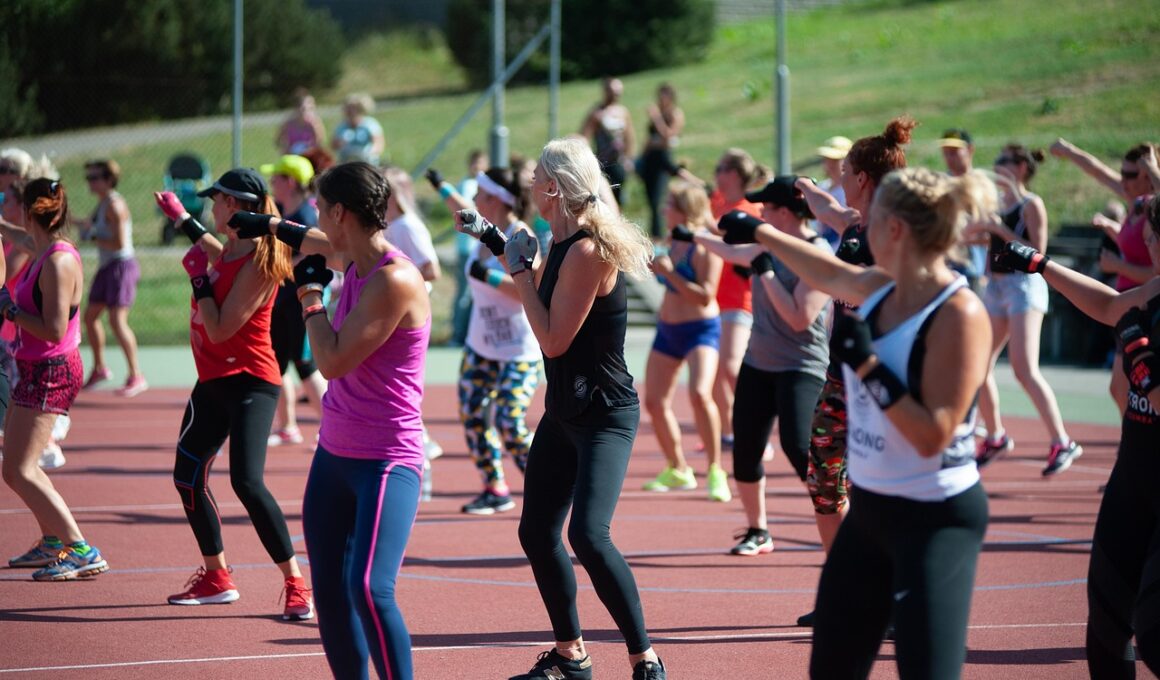Incorporating Interval Training into Cardio Dance Workouts
Cardio dance workouts are highly energetic and engaging, combining music and movement to create a fun exercise environment. Many fitness enthusiasts are now incorporating interval training into these routines to enhance their effectiveness. Interval training involves alternating periods of high-intensity work with recovery phases, which can optimize calorie burn and improve cardiovascular fitness. By integrating short bursts of intense activity followed by lower intensity, you’ll boost your metabolism and improve your overall endurance. This balance between different lengths of effort can help your body adapt gradually, making your workouts more effective over time. Furthermore, interval training can alleviate monotony, keeping sessions exciting and unpredictable. Participants often find that they engage more fully with the varied intensity, helping them to push through difficult workouts. Including intervals also allows for personalized exercise routines, enabling individuals to work according to their personal fitness levels. As you explore adding intervals, you’ll discover that they not only challenge you but also encourage progress. Socializing with friends in a refreshing dance setting while tackling interval training offers both health benefits and camaraderie, creating a holistic approach to fitness.
When designing a cardio dance workout with interval training, keep several elements in mind. First, consider the types of dance movements that fit well with high-intensity bursts. Activities such as jumping, fast-paced footwork, and vigorous arm movements are perfect choices for intervals. It’s also crucial to ensure that there are moments of active recovery. For example, after a high-energy interval, transitioning to slower dance styles can help in recovery without completely halting the movement. Selecting the right music can play a significant role in maintaining motivation and energy during your sessions. Upbeat, fast-tempo songs can drive high-intensity parts, while slower tracks can facilitate active recovery. Group classes present an excellent opportunity for adapting interval training, as the collective energy often elevates the experience. Encourage participants to take short water breaks as needed, and provide modifications for those seeking easier alternatives. Enhancing overall engagement fosters a supportive environment that helps everyone push their limits. As participants become more accustomed to the intervals, structure can shift towards more challenging workouts, allowing constant improvement.
Benefits of Interval Training in Cardio Dance
Incorporating interval training into cardio dance workouts presents numerous advantages for participants. One considerable benefit is improved cardiovascular health. This method stimulates heart and lung functions, leading to better oxygen delivery throughout the body. Furthermore, by boosting metabolism, interval training allows for more significant calorie burning during and after workouts. This phenomenon, known as the afterburn effect, enhances weight loss and fat burning even while at rest. Additionally, interval training can improve muscle conditioning by engaging different muscle groups during high-intensity intervals. This variety promotes muscular strength and endurance, crucial for overall fitness. Engaging in alternating intensity also reduces mental fatigue, making challenging workouts feel more manageable and enjoyable. Participants often experience reduced boredom, as the mix of speeds and styles keeps their minds engaged. The flexibility of interval training also allows for various adaptations suited to different skill levels. Beginners can start with shorter intervals, while seasoned dancers can push themselves with longer and more intense bursts. Overall, these benefits help ensure that classes remain dynamic and appealing, drawing participants back for more transformative experiences.
To optimize the effectiveness of interval training in cardio dance classes, participants should also be encouraged to listen to their bodies. High-intensity dance moves can be demanding, and it’s essential to emphasize the importance of recognizing personal limits. Modifications and alternative movements can help accommodate varying fitness levels within a single class setting. For instance, when someone feels overwhelmed by an intense burst, transitioning to a modified version helps maintain engagement without compromising effort or safety. To manage recovery periods effectively, consider employing active recovery techniques, like slow-paced dancing or gentle stretches. Such methods keep the body moving and prevent cooling down excessively. Engaging participants in this conversation about listening to cues will foster a sense of empowerment and self-awareness. Additionally, pairing intense intervals with educated coaching on form and technique can reduce the risk of injury, promoting overall wellness and balance. As participants become more in tune with their bodies, they’ll build greater confidence in pushing through future challenges. This holistic approach emphasizes wellness over competition, fostering an inclusive community within cardio dance workouts.
Designing an Effective Interval Structure
Structuring a cardio dance workout using interval training requires thoughtful planning to ensure maximum effectiveness. A popular schedule consists of a series of high-intensity bursts followed by varying durations of recovery. A suggested structure may consist of 30 seconds of high-energy movement paired with a 15 to 30 seconds slower recovery phase. This format not only maintains heart rates but also allows participants to prepare for the next burst of activity. When designing the high-intensity component, integrate quick footwork, jumps, and vigorous arm movements to capitalize on energy levels. You may also consider thematic intervals, where music tempo alternates, guiding the transitions through activity levels. Keep energy levels high by maintaining participants’ focus on the rhythm and beat. Adding a physical element, such as raising arms overhead or lunging, creates more engagement during intensity phases. Throughout the class, maintain a balance, ensuring ample time to catch breath. Leaning towards active recovery can keep momentum and engagement up while also allowing for muscle resting. Engaging participants with this structure helps promote enjoyment and achievement during every workout session, reinforcing the cycle of improvement.
While implementing interval training in cardio dance workouts, encourage participants to set personal goals between classes. Establishing objectives helps to keep commitment levels high and fosters continuous improvement. Goals may vary based on individual preferences and could range from simply increasing endurance to mastering a new dance routine with intense variations. Communicate the important role of consistency in achieving goals, reinforcing that progress takes time and dedication. Encouraging goal-setting can build a sense of community as participants share their achievements and challenges with fellow dancers. Establishing a support network within classes cultivates an inclusive atmosphere that motivates continued effort. Regular feedback from instructors can further reinforce progress in achieving individual goals. For those struggling to reach their targets, specific tips and modifications can help tailor workouts accordingly. Remember to celebrate milestones—big and small—among participants, creating an environment where progress is recognized. By fostering transparent communication and support, participants are more likely to find satisfaction and fulfillment in their fitness journeys.
Conclusion and Future Considerations
In conclusion, incorporating interval training into cardio dance workouts provides numerous physical and mental benefits. As participants combine music and varied intensity movements, they create an environment that elevates both fitness levels and enjoyment. With careful structuring of intervals, individuals can push through boundaries while discovering newfound confidence in their abilities. The varying pace keeps routines fresh, preventing boredom and promoting long-term adherence to fitness goals. Coaches and participants alike should remain committed to clear communication and foster a community that supports goal-setting. This emphasis on support can transform individual experiences into a collective journey of growth, enjoyment, and empowerment. Additionally, experimenting with various interval styles, music choices, and movement possibilities allows each class to remain unique and adaptable to diverse preferences. Think beyond the standard formats by introducing themed classes, challenges, or even dance styles that mix in different genres. By continuously innovating and allowing flexibility within cardio dance sports, fitness professionals can keep their programs thriving while participants embark on rewarding fitness journeys, elevating their overall well-being.
Embracing interval training in cardio dance is not merely a trend; it reflects changing methodologies aimed at improving physical health while making workouts enjoyable. As this approach grows in popularity, fitness experts and dancers alike will share insights on maximizing potential, refining techniques, and inventing new ways to keep classes dynamic. With an enthusiastic and motivated community, cardio dance with interval training can redefine standard workout experiences. Encouragement and partnerships among participants can lead to innovative developments within the dance fitness landscape. In the future, keep an eye for how technology, such as fitness apps and virtual classes, may further expand these offerings. With ongoing research and emerging practices, the foundation for safe and enjoyable fitness experiences will keep evolving, ensuring growth opportunities remain abundant for both instructors and dancers. In raising awareness about the possibilities created by interval training, you’ll inspire others to discover and embrace unique approaches to cardiovascular health. Building this momentum in cardio dance programs can create a lasting impact on wellness—turning challenging workouts into enjoyable and inclusive activities that attract more individuals into embracing active lifestyles.


